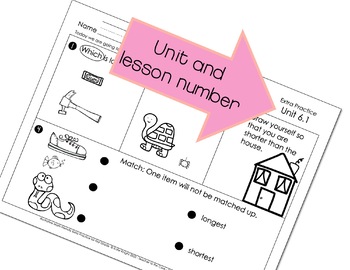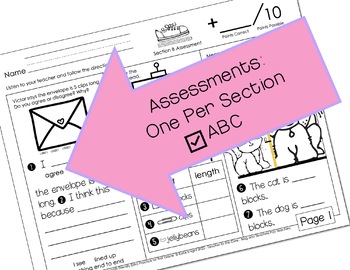Illustrative Math Homework and Assessments Unit 6
Teacher to the Core
12.9k Followers
Grade Levels
1st
Subjects
Resource Type
Standards
CCSS1.MD.A.1
CCSS1.MD.A.2
CCSSMP1
CCSSMP3
Formats Included
- PDF
Pages
18 pages
Teacher to the Core
12.9k Followers
What educators are saying
I love using this resource in my Illustrative Math lessons. It gives the students extra practice which is always beneficial.
Every single one of these units is worthy of purchase. The only thing that keeps me sane while teaching IM. Best resources on TPT.
Also included in
- This is a bundle of all first grade Illustrative Math-Friendly Units 1-8. You will have an extra practice for every lesson in the IM math program. 146 practice pages that can be used as year-long:Cool-downs or homeworkUnit 1 - 14 lessonsUnit 2 - 22 lessons Unit 3 - 29 lessonsUnit 4 - 23 lessonsUnitPrice $70.00Original Price $80.00Save $10.00
Description
This resource is an Illustrative Mathematics friendly unit. Use for extra practice / homework and to monitor understanding with 3 assessments. It is carefully designed to be Illustrative Math friendly and kid-friendly.
Extra Practice / Homework and 3 Assessments : (See every page in the preview)
- 1 extra practice page per lesson
- 17 lessons in this resource !!!
- Supports vocabulary
- Lesson format is extended here
- Kid-friendly graphics and topics
- Supports game-play
- Can be sent home as homework or used in class
- Each page can be used as a quiz, exit ticket, or cool down
- Can be used outside of the IM program as standards-based math practice.
- 3 Assessments
Assessments
- Section A
- Section B
- Section C
Will you be making other units?
- Yes!
- I need this extra practice as much as you do!
- I plan to post a unit every few weeks.
What Units are available?
- ⭐ Unit 1 Posted August 25th
- ⭐ Unit 2 Posted Sep 7
- ⭐ Unit 3 Posted Sep 18th
- ⭐ Unit 4 Posted October 1
- ⭐ Unit 5 Posted October 9
- ⭐ Unit 6 Posted October 30
- ⭐ Unit 7 Posted Dec 6
- ⭐ Unit 8 Wahooooo!
Will you bundle?
- ⭐ Unit 1-8 Bundle is posted!
Total Pages
18 pages
Answer Key
N/A
Teaching Duration
3 Weeks
Report this resource to TPT
Reported resources will be reviewed by our team. Report this resource to let us know if this resource violates TPT’s content guidelines.
Standards
to see state-specific standards (only available in the US).
CCSS1.MD.A.1
Order three objects by length; compare the lengths of two objects indirectly by using a third object.
CCSS1.MD.A.2
Express the length of an object as a whole number of length units, by laying multiple copies of a shorter object (the length unit) end to end; understand that the length measurement of an object is the number of same-size length units that span it with no gaps or overlaps.
CCSSMP1
Make sense of problems and persevere in solving them. Mathematically proficient students start by explaining to themselves the meaning of a problem and looking for entry points to its solution. They analyze givens, constraints, relationships, and goals. They make conjectures about the form and meaning of the solution and plan a solution pathway rather than simply jumping into a solution attempt. They consider analogous problems, and try special cases and simpler forms of the original problem in order to gain insight into its solution. They monitor and evaluate their progress and change course if necessary. Older students might, depending on the context of the problem, transform algebraic expressions or change the viewing window on their graphing calculator to get the information they need. Mathematically proficient students can explain correspondences between equations, verbal descriptions, tables, and graphs or draw diagrams of important features and relationships, graph data, and search for regularity or trends. Younger students might rely on using concrete objects or pictures to help conceptualize and solve a problem. Mathematically proficient students check their answers to problems using a different method, and they continually ask themselves, "Does this make sense?" They can understand the approaches of others to solving complex problems and identify correspondences between different approaches.
CCSSMP3
Construct viable arguments and critique the reasoning of others. Mathematically proficient students understand and use stated assumptions, definitions, and previously established results in constructing arguments. They make conjectures and build a logical progression of statements to explore the truth of their conjectures. They are able to analyze situations by breaking them into cases, and can recognize and use counterexamples. They justify their conclusions, communicate them to others, and respond to the arguments of others. They reason inductively about data, making plausible arguments that take into account the context from which the data arose. Mathematically proficient students are also able to compare the effectiveness of two plausible arguments, distinguish correct logic or reasoning from that which is flawed, and-if there is a flaw in an argument-explain what it is. Elementary students can construct arguments using concrete referents such as objects, drawings, diagrams, and actions. Such arguments can make sense and be correct, even though they are not generalized or made formal until later grades. Later, students learn to determine domains to which an argument applies. Students at all grades can listen or read the arguments of others, decide whether they make sense, and ask useful questions to clarify or improve the arguments.






